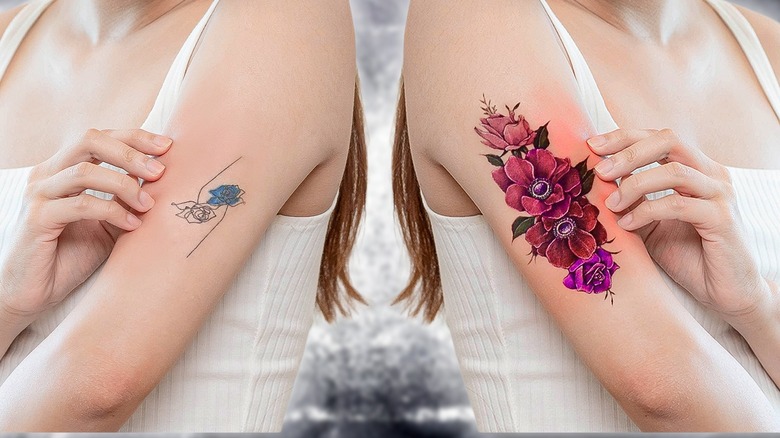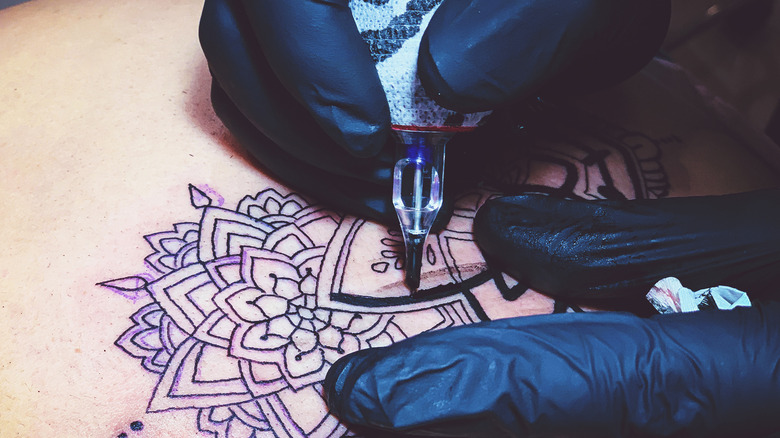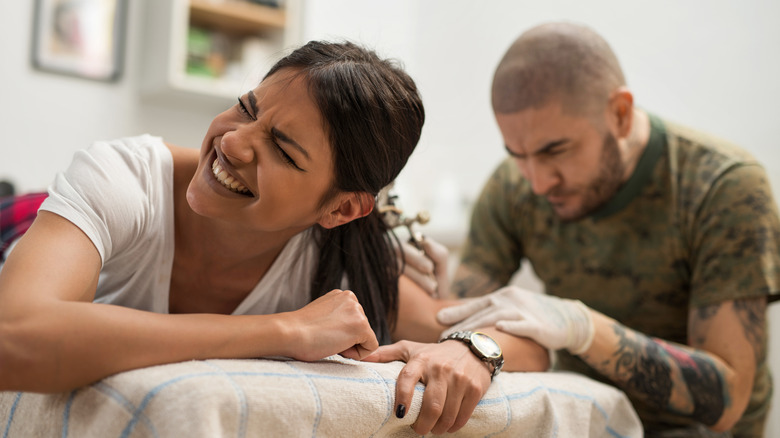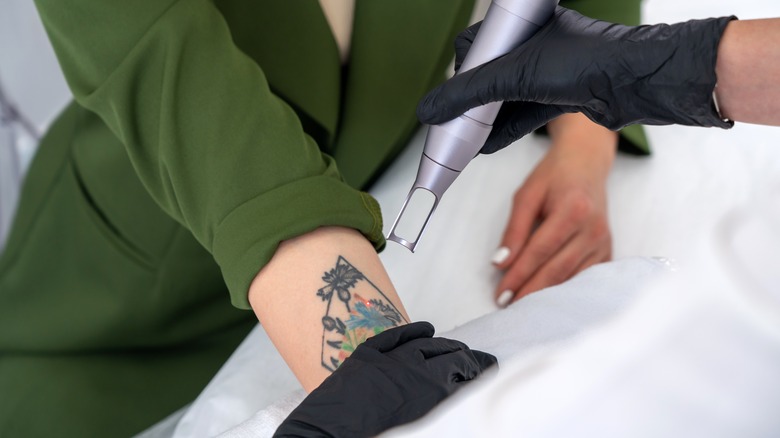What To Expect When You Go For A Tattoo Coverup
Over the past few decades, the perception of tattoos as taboo has significantly faded. Having ink is no longer considered an automatic disqualifier for many jobs, nor is it a cause for social concern. In fact, according to Rasmussen Reports, almost 50% of Americans younger than 40 had at least one tattoo as of 2022. While this progression may be a positive sign for societal evolution, it does create a reality where more people are facing a particular dilemma: tattoo regret.
Even celebrities like Megan Fox and Angelina Jolie have famously chosen to cover their old tattoos with new ones to usher in a new era. Fox had a tattoo of her ex-husband's name covered with a snake amidst a bed of flowers. If you're the owner of a tattoo that no longer brings you joy, it may be possible to have it covered with one you love, but there are factors for you and your tattoo artist to consider.
Artist expertise
When selecting an artist for an original tattoo, it's best to browse through their work and choose someone with the appropriate style and skill level for your desired design. However, picking an artist for a coverup tattoo requires a different approach. When a new tattoo is applied over an old one, the inks will mix, resulting in a color that may not match either the old or the new ink.
An experienced coverup artist will plan ahead and compensate for issues such as color mixing, ensuring that you don't end up with another tattoo that isn't what you want on your body. It is always advised to seek out a skilled artist who specializes in coverups rather than one based solely on their original designs, even if the cost may be higher. The peace of mind that comes with knowing your permanent tattoo is in expert hands is worth every penny.
Size and placement
Typically, for a coverup tattoo to adequately blend and cover the edges of the original tattoo, it needs to be bigger in size. "My rule of thumb is that they need to be two to three times the size of the original tattoo we are covering," tattoo artist Amanda Graves told Female Tattooers. "A lot of the technique is tricking the eye away from what we are making go away."
If your original tattoo was in a very small area such as a finger, toe, or ear, this could make a coverup tattoo very challenging, if not impossible. Space is limited and ink is more likely to blur in these spots. Therefore, it's essential to work closely with an artist skilled in coverups who is honest about their limitations.
The truth is, not every tattoo can be covered. When this is the case, you may need to consider temporary coverup options like body concealer or strategic clothing. Laser removal is also a possibility. Consulting with a specialized tattoo artist should always be the first step, followed by considering other medical and non-medical options.
Style and color palette
When considering whether a coverup is appropriate, an experienced artist will take into account the style and coloring of your existing tattoo. If a coverup is possible, the design will be limited by the original tattoo's appearance. For example, a black or darkly colored tattoo typically cannot be covered with a lighter-colored one, as the darker color will show through. But that doesn't mean you don't have options. "I have covered very black tattoos with a lot of open mindedness from the client on the design," explained Graves. "It can be done, but it depends on what you're looking to cover it with."
Similarly, the design of the tattoos must be factored in. If the original design features heavily rounded linework, like a lace pattern, it cannot be adequately covered by a design that features sharp, straight lines. A similarly rounded design, such as a mandala, would be a more appropriate choice to cover a lace tattoo. Your tattoo artist's expert guidance will be invaluable in helping you to maximize the effectiveness of a coverup.
Are coverups more painful?
Many people wonder if getting a tattoo applied over existing ink will be more painful than when they received the original design. The answer can vary from one client to another. The tattooing process creates scar tissue and, in rare cases, nerve damage. The level of scarring and potential nerve damage that took place during the original tattoo process will determine whether you will experience an elevated level of pain when you undergo a tattoo coverup.
Even if you do experience more pain during a coverup tattoo session than you did with the original, it will still likely be less painful than undergoing laser tattoo removal. Both processes tend to lead to pain and discomfort, but laser removal utilizes technology that causes tattoo ink particles to literally burst beneath the skin's surface, resulting in a very uncomfortable sensation that some compare to a severe blistering sunburn (via RenewMD).
Coverup versus removal
If you're considering booking a coverup tattoo appointment, you may have also thought about laser removal to get rid of your tattoo. However, if a tattoo isn't a good candidate for a coverup, laser removal technology is the only other permanent option. According to the Dermatology and Skin Cancer Institute, you'll typically need to undergo the procedure as many as 10 or more times to fully remove a tattoo. Since each appointment is likely to cost you hundreds of dollars, removal is a major investment.
Another option is to combine laser removal and a coverup tattoo. In cases where the original tattoo is very dark or the desired coverup design doesn't blend well, fading the original through laser removal to allow for better coverage is a possibility. This route can sometimes be achieved by undergoing just two or three laser removal sessions before having the coverup applied. Consult with your coverup artist for specific recommendations for your individual circumstances.





